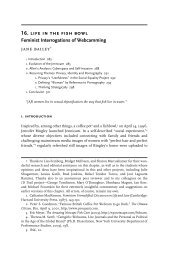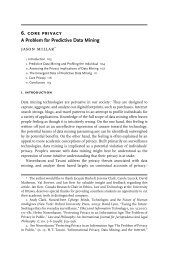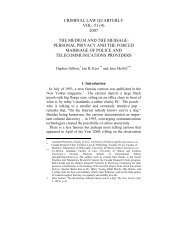Complete Cases Chart - Supreme Court of Canada - On the Identity ...
Complete Cases Chart - Supreme Court of Canada - On the Identity ...
Complete Cases Chart - Supreme Court of Canada - On the Identity ...
Create successful ePaper yourself
Turn your PDF publications into a flip-book with our unique Google optimized e-Paper software.
Case Name (<strong>Court</strong>)<br />
(Judge)<br />
Location/Method <strong>of</strong> Search Relevant Statutes Issues/Holdings<br />
- (1) whe<strong>the</strong>r <strong>the</strong> search violates s. 8 <strong>of</strong> <strong>the</strong>C<strong>Chart</strong>er? - Y/N<br />
- (2) whe<strong>the</strong>r to exclude evidence by s. 24(2)? – Y/N<br />
Reasoning<br />
- (1) relevant to s.8 + CASES (Kokesch, Plant, Hunter, Tessling, Edwards)<br />
- (2) relevant to 24(2) + CASES (Collins)<br />
[2004] 192 O.A.C. 71<br />
Rosenberg J.A.;<br />
Armstrong and Blair<br />
JJ.A. (con).<br />
* final level - SCC<br />
leave to appeal<br />
refused<br />
<strong>Identity</strong> – Records<br />
withheld<br />
R. v. Tessling<br />
[2003]168 O.A.C. 124<br />
Abella J.A.; O’Connor<br />
A.C.J.O and Sharpe<br />
J.A. (con).<br />
*reversed SCC (leave<br />
to appeal)<br />
Property – Home;<br />
Surveillance – FLIR<br />
company and was not<br />
providing all <strong>the</strong> necessary<br />
records.<br />
- Health records were seized<br />
by police who were seeking<br />
allegedly fabricated and<br />
falsified information.<br />
- <strong>On</strong> <strong>the</strong> strength <strong>of</strong><br />
information gained from two<br />
informants, police used FLIR<br />
technology to obtain a<br />
<strong>the</strong>rmal image <strong>of</strong> <strong>the</strong> home <strong>of</strong><br />
<strong>the</strong> accused.<br />
• NO<br />
- (2) No discussion <strong>of</strong> s.24(2).<br />
- <strong>Chart</strong>er, ss.8 and 24(2). - (1) Did <strong>the</strong> search and seizure violate s.8?<br />
• YES<br />
- (2) Should <strong>the</strong> evidence be excluded?<br />
• YES<br />
- The Application Judge noted <strong>the</strong> universal concern for privacy with regard to<br />
health records.<br />
- S.487 <strong>of</strong> <strong>the</strong> Criminal Code balances private/public rights.<br />
- It was not confidential health information that was sought, but evidence <strong>of</strong> fraud.<br />
- Ref. to O’Connor (reasonable expectation <strong>of</strong> privacy re records held by 3 rd<br />
parties).<br />
- Ref. to Dyment (serious nature <strong>of</strong> intrusion into health record).<br />
- Ref. to Hunter v. Southam ((in Dyment) where it’s feasible to obtain prior<br />
authorization, such authorization will be considered a pre-condition).<br />
- (1) The appellant had a reasonable expectation <strong>of</strong> privacy in activities carried on<br />
within his residence. FLIR violated this expectation. No reasonable expectation <strong>of</strong><br />
privacy exists for heat emanating from a home, but here <strong>the</strong> information revealed<br />
activities within <strong>the</strong> house.<br />
- Ref. to Edwards (two-step s.8 test).<br />
- Ref. to Plant (no reasonable expectation <strong>of</strong> privacy re records held by a third pary;<br />
core biographical information; electricity consumption records fall outside this<br />
protection and are accessible to <strong>the</strong> public).<br />
- Ref. to Kelly (reasonable expectation <strong>of</strong> privacy from low-level aerial<br />
surveillance).<br />
- Ref. to Hunter v Southam ((in Evans) s.8 applies where a reasonable expectation<br />
<strong>of</strong> privacy has been diminished by an investigatory technique).<br />
- (2) The FLIR technology revealed activities inside <strong>the</strong> home beyong what would<br />
be detectable by normal observation or surveillance.<br />
- The search warrant was not lawfully obtained.<br />
- This will enhancee public confidence.<br />
144096 <strong>Canada</strong> Ltd.<br />
v. <strong>Canada</strong> (Attorney<br />
General)<br />
[2002] 168 O.A.C. 201<br />
Morden J.A.; Borins<br />
and Simmons JJ.A.<br />
(con).<br />
* no history<br />
- Six aircraft were in storage<br />
temporarily “for <strong>the</strong> winter”.<br />
- <strong>Canada</strong> Customs seized and<br />
stored <strong>the</strong> six aircraft and<br />
later ano<strong>the</strong>r, on <strong>the</strong> basis <strong>of</strong> a<br />
breach <strong>of</strong> <strong>the</strong> Customs Act.<br />
- The appellant alleges that<br />
<strong>the</strong> aircraft were damaged<br />
while improperly stored.<br />
- Customs Act, s. 106(1)<br />
(any action must be<br />
brought within 3 months),<br />
a.129 (challenge to<br />
seizure);<br />
- Crown Liability and<br />
Proceedings Act, s.3(b);<br />
- <strong>Chart</strong>er, s.8.<br />
- (1) Did <strong>the</strong> seizure violate s.8?<br />
• NO<br />
- (2) No discussion <strong>of</strong> s.24(2).<br />
- Ref. to Kyllo v. US.<br />
- (1) There was no material on record to support a reasonable expectation <strong>of</strong> privacy.<br />
- The action commenced two years after <strong>the</strong> incident but <strong>the</strong> limitations period<br />
would actually have begun after <strong>the</strong> action was commenced (not from date <strong>of</strong> seizure<br />
but from date <strong>of</strong> <strong>the</strong> end <strong>of</strong> storage).<br />
- Appeal allowed (except <strong>Chart</strong>er issues dismissed).<br />
- Custom Officer’s malice and intent to injure bring issue outside scope <strong>of</strong> a.106(1).<br />
61







